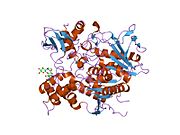Acetylcholinesterase
| acetylcholinesterase | |||||||||
|---|---|---|---|---|---|---|---|---|---|
| Identifiers | |||||||||
| EC no. | 3.1.1.7 | ||||||||
| CAS no. | 9000-81-1 | ||||||||
| Databases | |||||||||
| IntEnz | IntEnz view | ||||||||
| BRENDA | BRENDA entry | ||||||||
| ExPASy | NiceZyme view | ||||||||
| KEGG | KEGG entry | ||||||||
| MetaCyc | metabolic pathway | ||||||||
| PRIAM | profile | ||||||||
| PDB structures | RCSB PDB PDBe PDBsum | ||||||||
| Gene Ontology | AmiGO / QuickGO | ||||||||
| |||||||||
Template:FixBunching Template:PBB Template:FixBunching Acetylcholinesterase, also known as AChE, is an enzyme that degrades (through its hydrolytic activity) the neurotransmitter acetylcholine, producing choline and an acetate group. It is mainly found at neuromuscular junctions and cholinergic synapses in the central nervous system, where its activity serves to terminate synaptic transmission. AChE has a very high catalytic activity — each molecule of AChE degrades about 25000 molecules of acetylcholine per second. The choline produced by the action of AChE is recycled — it is transported, through reuptake, back into nerve terminals where it is used to synthesize new acetylcholine molecules.[1]
Acetylcholinesterase is also found on the red blood cell membranes, where it constitutes the Yt blood group antigen. Acetylcholinesterase exists in multiple molecular forms, which possess similar catalytic properties, but differ in their oligomeric assembly and mode of attachment to the cell surface.
In humans acetylcholinesterase is encoded by the ACHE gene.[2]
Species distribution
Acetylcholine is widely expressed in eukaryotes including at least some plants.[3]
AChE gene
In mammals, acetylcholinesterase is encoded by a single AChE gene while some invertebrates have multiple acetylcholinesterase genes. Diversity in the transcribed products from the sole mammalian gene arises from alternative mRNA splicing and post-translational associations of catalytic and structural subunits. There are three known forms: T (tail), R (read through), and H(hydrophobic).[4]
AChET
The major form of acetylcholinesterase found in brain, muscle, and other tissues, known as is the hydrophilic species, which forms disulfide-linked oligomers with collagenous, or lipid-containing structural subunits. In the neuromuscular junctions AChE expresses in asymmetric form which associates with ColQ or subunit. In the central nervous system it is associated with PRiMA which stands for Proline Rich Membrane anchor to form symmetric form. In either case, the ColQ or PRiMA anchor serves to maintain the enzyme in the intercellular junction, ColQ for the neuromuscular junction and PRiMA for synapses.
AChEH
The other, alternatively-spliced form expressed primarily in the erythroid tissues, differs at the C-terminus, and contains a cleavable hydrophobic peptide with a GPI-anchor site. It associates with membranes through the phosphoinositide (PI) moieties added post-translationally.[5]
AChER
The third type has, so far, only been found in Torpedo sp. and mice although it is hypothesized in other species. It is thought to be involved in the stress response and, possibly, inflammation.[6]
AChE inhibitors
Acetylcholinesterase is the target of many Alzheimer's Dementia drugs, nerve gases, particularly the organophosphates (e.g. Sarin) and insecticides (e.g. carbaryl). These agents — known as cholinesterase inhibitors — block the function of acetylcholinesterase and thus cause excessive acetylcholine to accumulate in the synaptic cleft. The excess acetylcholine causes neuromuscular paralysis (i.e. interminable muscle contractions) throughout the entire body, leading to death by asphyxiation.[1]
Cholinesterase inhibitor may also be used in treatment of Lewy Body Dementia.
An endogenous inhibitor of AChE in neurons is Mir-132 microRNA, which may limit inflammation in the brain by silencing the expression of this protein and allowing ACh to act an in anti-inflammatory capacity.[7]
See also
References
- ^ a b Dale Purves, George J. Augustine, David Fitzpatrick, William C. Hall, Anthony-Samuel LaMantia, James O. McNamara, and Leonard E. White (2008). Neuroscience. 4th ed. Sinauer Associates. pp. 121–2. ISBN 978-0-87893-697-7.
{{cite book}}: CS1 maint: multiple names: authors list (link) - ^ Ehrlich G, Viegas-Pequignot E, Ginzberg D, Sindel L, Soreq H, Zakut H (1992). "Mapping the human acetylcholinesterase gene to chromosome 7q22 by fluorescent in situ hybridization coupled with selective PCR amplification from a somatic hybrid cell panel and chromosome-sorted DNA libraries". Genomics. 13 (4): 1192–7. doi:10.1016/0888-7543(92)90037-S. PMID 1380483.
{{cite journal}}: Unknown parameter|month=ignored (help)CS1 maint: multiple names: authors list (link) - ^ Momonoki YS (1992). "Occurrence of Acetylcholine-Hydrolyzing Activity at the Stele-Cortex Interface". Plant Physiol. 99 (1): 130–133. doi:10.1104/pp.99.1.130. PMC 1080416. PMID 16668839.
{{cite journal}}: Unknown parameter|month=ignored (help) - ^ Massoulié J, Perrier N, Noureddine H, Liang D, Bon S (2008). "Old and new questions about cholinesterases". Chem Biol Interact. 175 (1–3): 30–44. doi:10.1016/j.cbi.2008.04.039. PMID 18541228.
{{cite journal}}: CS1 maint: multiple names: authors list (link) - ^ "Entrez Gene: ACHE acetylcholinesterase (Yt blood group)".
- ^ Dori A, Ifergane G, Saar-Levy T, Bersudsky M, Mor I, Soreq H, Wirguin I (2007). "Readthrough acetylcholinesterase in inflammation-associated neuropathies". Life Sci. 80 (24–25): 2369–74. doi:10.1016/j.lfs.2007.02.011. PMID 17379257.
{{cite journal}}: CS1 maint: multiple names: authors list (link) - ^ Shaked I, Meerson A, Wolf Y, Avni R, Greenberg D, Gilboa-Geffen A, Soreq H (2009). "MicroRNA-132 potentiates cholinergic anti-inflammatory signaling by targeting acetylcholinesterase". Immunity. 31 (6): 965–73. doi:10.1016/j.immuni.2009.09.019. PMID 20005135.
{{cite journal}}: CS1 maint: multiple names: authors list (link)
Further reading
External links
- ATSDR Case Studies in Environmental Medicine: Cholinesterase Inhibitors, Including Insecticides and Chemical Warfare Nerve Agents U.S. Department of Health and Human Services
- Proteopedia Acetylcholinesterase
- Proteopedia AChE_inhibitors_and_substrates
- Proteopedia AChE_inhibitors_and_substrates_(Part_II)
- Proteopedia AChE bivalent inhibitors AChE_bivalent_inhibitors AChE bivalent inhibitors



